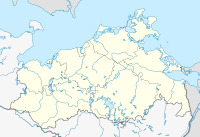Hauptmannsberg nature reserve
Coordinates: 53 ° 18 ′ 36 " N , 13 ° 26 ′ 36" E
The Hauptmannsberg nature reserve is a 43 hectare nature reserve in the east of Mecklenburg north of Carwitz .
Location and importance
The nature reserve comprises a striking section of a terminal moraine from the last Ice Age with wooded open land areas on the western shore of Lake Zansen . The eponymous Hauptmannsberg is located in the southern part and is 120 meters high.
The legal establishment of the protected area took place on March 20, 1957. It borders on the north and west lying nature reserve Hullerbusch and Schmaler Luzin .
The nature reserve is located in the Feldberger Seenlandschaft nature park and is classified as an FFH area and bird sanctuary under EU law .
The current state of the area is considered to be good, although the open land character of the areas is changing due to the resettlement of trees. The browsing promoted by sheep grazing and mechanical care measures cannot change this either.
Several public roads lead through the area. The hiking trail that runs through the area is a main tourist destination in the Feldberg lake landscape with its views of the lakes.
history
The areas were decisively shaped by the last ice age and postponed as terminal moraine. The Hauptmannsberg represents an end moraine . After the ice thawed, the boulders that are still visible today remained. Due to the sandy-gravelly subsoil, precipitation seeps away quickly, so that it is a dry location. Bronze Age barrows are evidence of early human settlement. The village of Hanow, which was founded in the 13th century, was abandoned in the 15th century and the land was then used by Carwitz farmers. On a map by Tilemann Stella from 1578, the areas are marked free of forests. In the 18th century, steep and impassable areas were abandoned and forested. The other areas were used alternately as meadows and fields. From the 1950s a 2 hectare area was afforested with pine trees in the central part. Agricultural use was given up in 1971. Regular grazing only started in 1992.
Flora and fauna
In the steep slope areas on the banks of the Zansen, forests with hornbeam , red beech and oak grow , and hazel is scattered . After it was abandoned in the middle of the 20th century, broom , blackberries and sloe were able to spread. The areas that are kept open are covered by species-poor red ostrich grass corridors and carnations - fescue lawns . The plant communities with steppe timothy and oat, bound to locations rich in bases, can only be found in small areas .
Numerous warmth- loving cicadas and grasshopper species inhabit the area, including the little heather grasshopper and the two-colored bite insect . The breeding bird world has changed in recent decades due to changes in the areas. Today there are mainly species that live in hedge and forest, such as the sparrowhawk , red-backed killer , sprout and wryneck .
literature
- Hauptmannsberg nature reserve 60 . In: Ministry of Environment Mecklenburg-Western Pomerania (Hrsg.): The nature reserves in Mecklenburg-Western Pomerania . Demmler-Verlag, Schwerin 2003, ISBN 3-910150-52-7 , p. 380 f .
Web links
- Literature about the nature reserve Hauptmannsberg in the state bibliography MV
- Map portal environment of the State Office for the Environment, Nature Conservation and Geology Mecklenburg-Western Pomerania ( information ) with geodata




